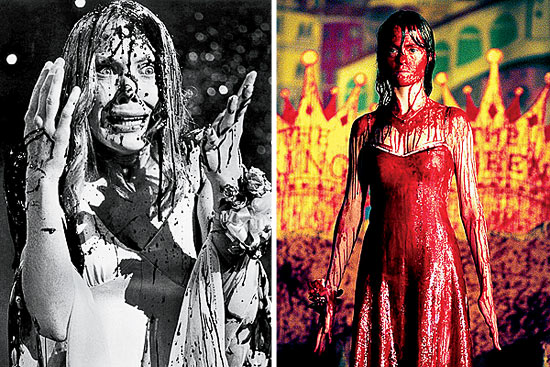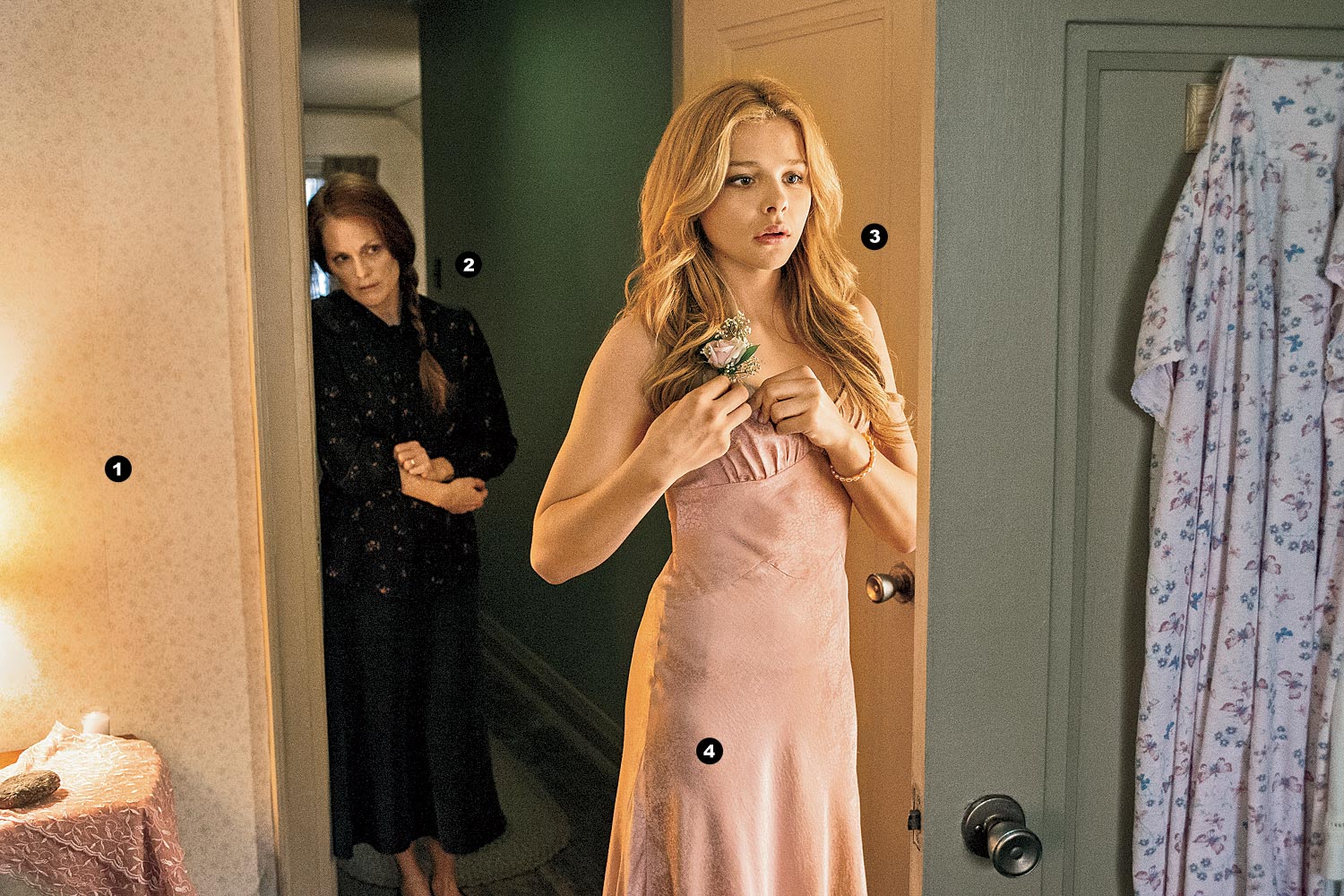This Friday, October 18, a new adaptation of Stephen King's 1974 horror novel, Carrie, hits theatres. It's already drawing comparisons to Brian de Palma's 1976 classic by the same name.
Fans of the original flick can expect more emphasis on Carrie’s relationship with her mother, Margaret (Julianne Moore). Director Kimberly Peirce calls that the “heart and soul” of the story.
Here, she discusses the well-researched elements of an ominous scene between the two as Carrie (Chloë Grace Moretz) prepares for the prom.
1. The Eerie House
“The walls are beautifully worn down,” says Peirce of the yellowed, dirt-covered panels created by set designer Carol Spier (Eastern Promises). “You would imagine they were painted 20 years ago.”
2. The Overbearing Mother
“They’re completely codependent,” says Peirce of Margaret White (Julianne Moore) and her daughter. Margaret spends much of the film beating and verbally abusing Carrie, but here, as she lurks in the doorway, the tables have turned. “Carrie has become the woman of the house.”
3. The Sheltered Daughter
To play up Carrie’s isolation, the director encouraged Chloë Grace Moretz to untether herself from her family and creature comforts. She even went so far as to bring the 16-year-old to a homeless shelter to help her identify with some of Carrie’s issues.
4. The Prom Dress
After looking at hundreds of dresses, Peirce finally landed on a simple design in a basic fabric. “It had to be aspirational and fancy, but we also wanted it to be something Carrie could have made herself.”
A Q&A with Director Kimberly Peirce
Movie director Kimberly Peirce (Boys Don’t Cry) doesn’t shy away from tough topics such as sexuality, androgyny, and violence. So when the University of Chicago graduate signed up to remake the iconic horror film Carrie based on the book by Stephen King, she dove right in to the story’s themes of bullying, female empowerment, and religious fundamentalism. Chicago sat down with Peirce to discuss her remake.
Carrie is a story that has already lived nine lives (see “Carrie Through the Years,” below), why make this movie now?
Well, first, I read the book three times and fell madly in love with Carrie. She’s an extraordinary character. She’s a misfit with an incredibly strong need to find love and acceptance. I also thought this was an opportunity to tell a superhero origins story: With the period comes the power. In the beginning, Carrie doesn’t know how big her powers can go, and that’s something we could track. That’s great because it’s what you get in these super hero movies like Superman and Spiderman.
Stephen King presciently observed the issues of bullying, religious radicalism, and female empowerment in his 1974 novel. How did you turn those issues into entertainment in a post-Columbine era?
It’s interesting; I’ve noticed there are a lot more of these types of stories, avenger and superhero type stories. In an era like this when there is far more violence in everyday life and culture, people must feel insecure, which must be why we really love superhero stories. Superheroes make us feel safer; they’re a reflection of us because he or she is usually a bullied weakling who gets powers and seeks out justice. Maybe it’s our sense of vulnerability, but it’s a blast to see somebody get the power that we could like to have.
There are several classic American superhero comics written by Jews in the 1950s.
There are. That was a level of disempowerment. They wanted to be über powerful. Maybe in the 1970s you had less of this, but now, there’s a lot more violence in our everyday life and culture and everyday entertainment.
Switching gears, can you talk about your decision to cast Chloë Grace Moretz?
One thing I really love about Chloë is that she has movie start quality. The camera loves looking at her. She’s utterly entertaining; she’s got a great voice and she’s really charismatic. I also thought she was the right age because she is truly a teenager. And that meant she was going through a lot of things the real Carrie was going through. One challenge, however, was that Chloë is a child star and is used to a certain comfortable lifestyle that is very different from Carrie. In a lot of ways, Carrie and Chloë are opposites. But that’s the magic of a great actor.
It’s a big coup for the film to have Julianne Moore star as Carrie’s extremely religious mother Margaret. Did you have to change the character in order to better reflect the current role of religious fundamentalism in American culture?
When Brian de Palma first cast this role, he was bringing religious fundamentalism into popular culture in ways people hadn’t really seen before. And once he introduced it, people loved it, and it worked great [in the film]. Cut to 40 years later, religiosity has played a new role. It’s much more front and center and it’s much more in the media. If you have a character that’s excessive and religious you run the risk of mocking that character. But with an actress like as gifted and amazing as Julianne Moore, we could work on conveying Margaret as an antagonist who the audience could identify with.
What was Moore’s relationship like with Moretz on set?
Two things happened. They had a real mother, daughter relationship. Chloë is a real teenager and Julianne is a wonderful mother who really privileges family. So they bonded. The other thing was that as Chloë worked with Julianne, who is an extraordinary actor, she just got better and better; better actor makes better actor. We all felt it on set. We said we were lost in the White House [Carrie’s house] during that time.
The house plays an important role in the movie. How did you design it and what did you want to convey?
We really wanted to differentiate the house from the rest of the outside. The house is a safe space for Margaret. She also beats Carrie, and she only beats her inside the house. That’s why Carrie never wants to go inside. It’s a very emotional movie and Carrie’s powers erupt from emotion. The house feels the relationship between the women. We built in this wonderful soundscape that reacts to how the two women engage each other. It mourns, aches, and grieves with the women, and in the end, it dies with them.
Carrie Through the Years

1974: Stephen King’s best-selling novel is one of the first books to take on bullying and religious radicalism.
1976: Brian De Palma’s blood-soaked movie premieres to critical and commercial acclaim; two Oscar nominations later, it’s a Halloween classic.
1988: An $8 million musical adaptation becomes one of the most expensive flops in Broadway history.
1999: The Rage: Carrie 2 hits movie theatres. Don’t remember it? Neither does anyone else.
2002: Writer Bryan Fuller (Dead Like Me, Heroes) pens a two-hour NBC special with a PG rating. Nuff said.
2012: Off Broadway takes a stab— this time the musical survives 34 previews and 46 shows.
2013: Kim Peirce releases her remake. She will discuss the film at the Humanities Festival on November 9. For info, chicagohumanities.org



